by Margaret Linford | Dec 20, 2017 | 01 What's New, Cemeteries |
Cemetery research is a crucial family history skill. Tombstones are monuments to our ancestors lives and may have key genealogical clues engraved in the stone. Follow these four steps to finding your ancestors’ burial places and the records that complement them.
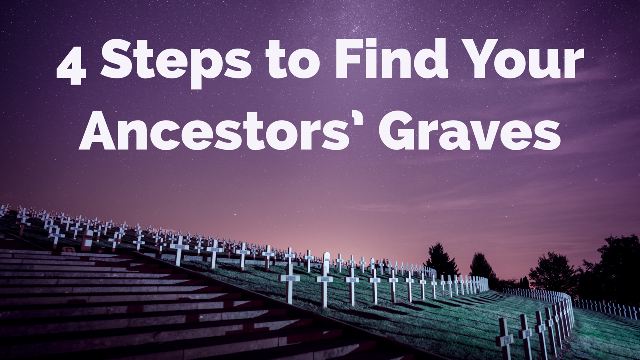
Many of my ancestors are buried just two miles from my house in Round Hill Cemetery in Marion, Virginia. I drive by the cemetery each day, as I take my daughters to school. I never pass by without glancing up at the hallowed ground which holds the remains of those who came before me. The sun perfectly illuminates their resting place each morning and a majestic tree stands at the very top of the hill–a living monument to the lives they led in the town where I now raise my own family.
It is an emotional experience to stand in the place where an ancestor’s remains have been laid to rest.
Each time I visit the grave of my grandma, I have a vision of a family standing around a casket on a bitter cold day in March. It was a just few days before the official start of spring, but it was the dead of winter to me. That ground is sacred to me, now.
Each time I visit, I am transported back in time to that day. A wound is re-opened for a moment, but the moment is fleeting because I quickly remember her life, not her death.
I remember the stories she told, the service her hands rendered to her family and, most importantly, the love that transcends time and even the icy grip of death. Death truly loses its “sting” as we stand before a monument of stone and see beyond to the life it represents. Scenes like this one have played out at each grave.
I am reminded of this quote from Fear Nothing, a Dean Koontz book, whenever I visit the cemetery:
“The trunks of six giant oaks rise like columns supporting a ceiling formed by their interlocking crowns. In the quiet space below, is laid out an aisle similar to those in any library. The gravestones are like rows of books bearing the names of those whose names have been blotted from the pages of life; who have been forgotten elsewhere but are remembered here.”
I have often gone to my ancestors’ resting places to take pictures of headstones and search for relatives I may have missed in the past. It seems like each time I visit, I notice something new.
This library of marble holds many clues that have helped me break down brick walls in my family history research. These clues have been there, etched in stone, for decades. It wasn’t until I recognized how to read the clues that I began to understand the importance of cemeteries in family history research.
These resting places have become much more to me than merely a place to go and offer a bouquet of flowers. There are answers waiting to be discovered. The key to getting the answers is knowing which questions to ask.
In my experience, the best genealogists are not the ones with the best cameras, the best software, or the best gadgets–they are the ones with the best questions.
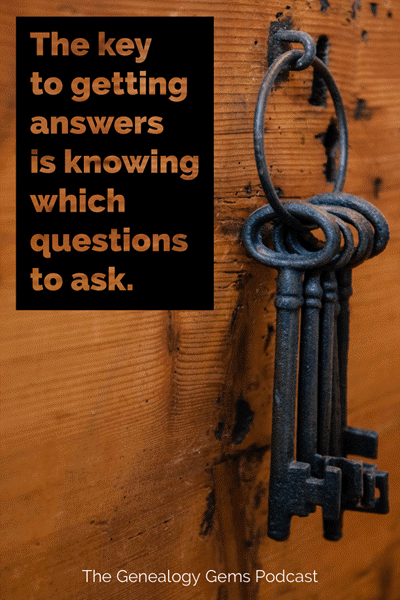
Curiosity is the most important tool to the successful genealogist. The next time you find yourself in a library of marble, take a few moments to let your curiosity run wild. Ask yourself:
- “Who are the people surrounding my family members?
- What are their stories?
- What do the etchings on their headstones mean?”
That curiosity will lead to the most remarkable discoveries and you will see for yourself how a piece of marble truly can break down a brick wall.
Below I’ve outlined the steps for finding family cemeteries and which questions you should be asking when you get there. Get inspired by my own examples of breaking down brick walls, and implement these methods I used for your own success!
Cemetery research step #1: Identify the cemetery
The first step in cemetery research is to identify the name of the cemetery where an ancestor was buried.
The best places to start looking are death certificates, funeral home records and obituaries. Each one of these records should contain the name of the cemetery where a family member was buried.
We sometimes fail to look beyond the names and dates on death certificates. If we get in the habit of taking the time to absorb all of the information on these important documents, we will find genealogical treasure.
Sometimes, the death certificate will not give us the name of the cemetery.
This was the case with my great-grandmother, Mollie Weimer Overbay. I was frustrated to see that the death certificate only indicated that she was buried, as opposed to cremated or removed to another location. While the certificate did not provide me with the name of a cemetery, it did offer the name of the funeral director: W.B. Seaver.
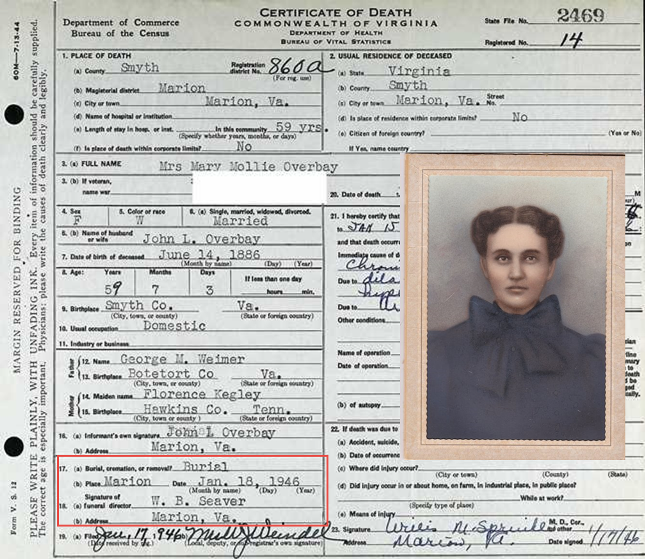
Luckily, I was able to follow this lead to the local funeral home. Within their records, I discovered that she was buried in Round Hill Cemetery, along with many of my other ancestors.
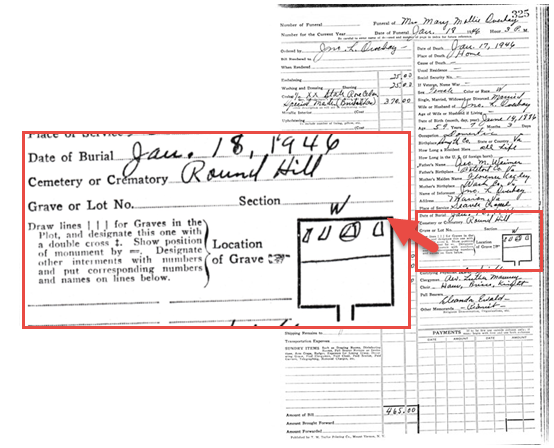
Cemetery research step #2: Locate the cemetery
Once you have located the name of the cemetery, several resources can guide you to its location.
Three helpful websites are listed below. Which you choose may depend on personal preference or familiarity but also on which site seems to have more records for the locales of most interest to you.
1. One of my favorite online resources is Find A Grave.
This website allows you to search for cemeteries all over the world.
At the home page, click on the Cemeteries tab (#1, below).
Then enter the name or location of the cemetery (#2). In the screenshot below, you can see part of the Google Maps interface that shows you the exact location of the cemetery, should you want to visit in person:
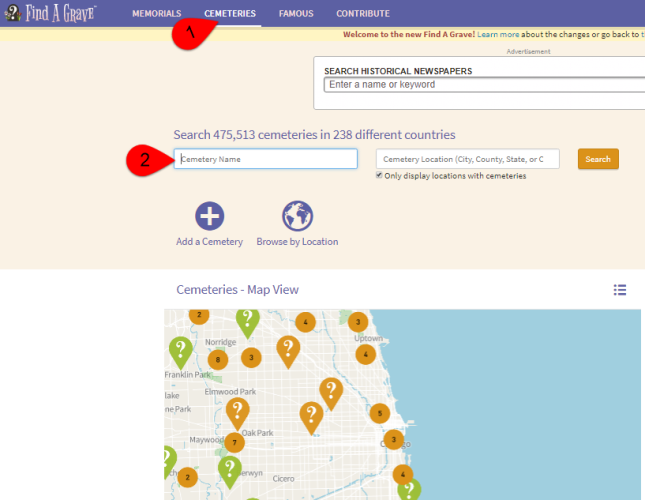
Find A Grave also has pictures of many of the headstones located within cemeteries.
2. 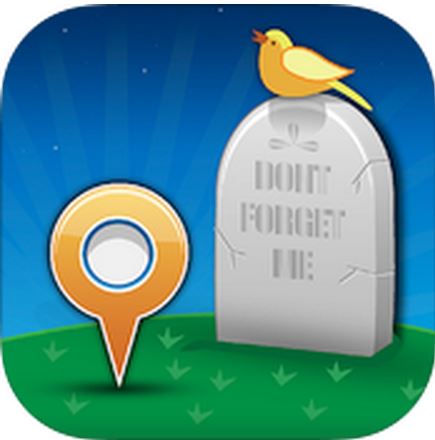 Billion Graves allows users to collect photos of headstones by using an iPhone/Android camera app.
Billion Graves allows users to collect photos of headstones by using an iPhone/Android camera app.
The app, available on Google Play and the App Store (for iPhone and iPad), tags the photos with the GPS location and, essentially, maps the cemetery as headstones are added.
Search for cemetery locations using the Billion Graves app or on the website by selecting the “Cemetery Search” option and then entering the name of the cemetery or a known address (to see it on Google Maps):
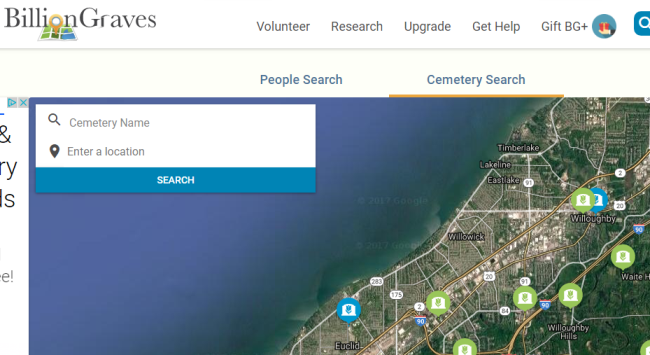
3. Interment.net can also be helpful.
From the home page, scroll down just a little until you see “Browse Cemetery Records by Region.” This can be especially helpful if you’re looking for all records within a specific county or other region. However, it’s not quite as useful if you’re trying to locate all cemeteries within a certain radius of a location, regardless of local boundaries.
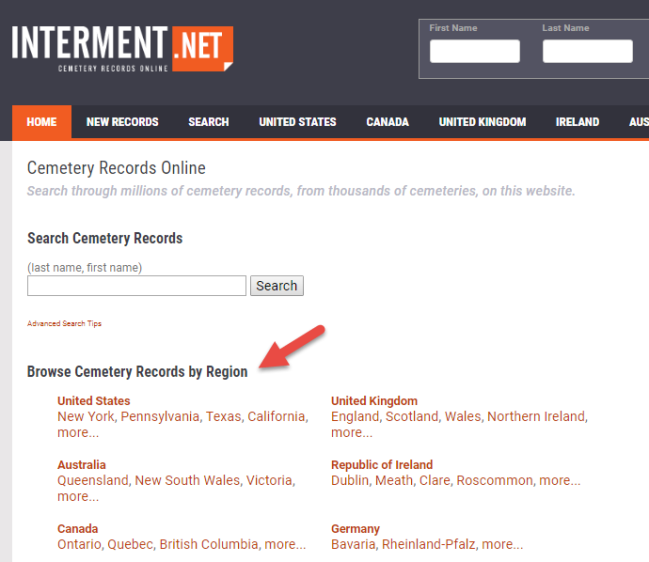
In addition to these resources, it is essential to contact the local library, genealogical society, and/or historical society where your ancestors are buried. These organizations are well-known for maintaining detailed listings of local cemeteries within their collections.
For instance, within Smyth County (where I live) there is a four-volume set of books that contains the work of two local historians, Mack and Kenny Sturgill. They spent several years mapping local cemeteries and collecting the names on all of the headstones.
Although these books were completed in the 1990s, the information is still valuable to genealogists. Detailed driving directions were given to help future researchers locate cemeteries that would otherwise be difficult to locate. Many of them are on private property and even in the middle of cow pastures or wooded areas.
Furthermore, some of the headstones that were legible in the 1990s have now become difficult to decipher due to weathering or have altogether disappeared. It is likely that the counties in which you are conducting cemetery research offer similar resources.
Cemetery research step #3: Prepare for a visit
Once you have found the cemetery you want to visit, you will want to take the following items along with you to make the most of your visit:
- a camera
- pair of gloves
- grass clippers
- notebook and pen
- long pants
- sturdy shoes
You may also want to use a damp cloth to bring out the carvings on headstones. A side note: if you are like me and have an aversion to snakes, you will either choose to go on cemetery expeditions during the winter, or you will invest in a pair of snake chaps.

Get more help! The Family Tree Cemetery Field Guide (above) contains detailed step-by-steps for using FindAGrave and BillionsGraves, plus guides for understanding tombstone epitaphs and symbol meanings.
Disclosure: Genealogy Gems is a participant in the Amazon Services LLC Associates Program, an affiliate advertising program designed to provide a means for sites to earn advertising fees by advertising and linking to Amazon.com. Thank you for supporting our free podcast by using our link.
Cemetery research step #4: Visit and search for clues

This headstone shows something unusual: the couple’s ham radio call signs (the codes engraved just below their names).
The headstones found in cemeteries can reveal much about your family. You will find more than birth and death dates. If you look closely, you will discover symbols related to military service and religious beliefs, maiden names of the women in your family, and you may even find family members that you never knew about. Many times, you will find children buried in the family plot. Look around to see who is buried near your ancestors. It is likely that you will find connections to other family members when you are visiting the cemetery. These connections may lead you to break down long-standing brick walls within your family history.
In my own experience, there have been several instances in which cemetery research has helped shed light on a family mystery. I had grown up hearing that there were members of our family who had fought in the Civil War. Who were these men? What experiences did they have during the war? Where had they fought?
The answers to these questions came as the result of a visit to the cemetery. I had gone to Round Hill Cemetery to photograph the headstones of my Weimer ancestors. As I worked my way down the row, I encountered an unfamiliar name—William Henry Wymer. At the top of his headstone, there was a Southern Cross of Honor—a symbol used to denote a soldier who fought during the Civil War. Below his name was the following inscription: “Co. A, 6 VA RES, C.S.A:”
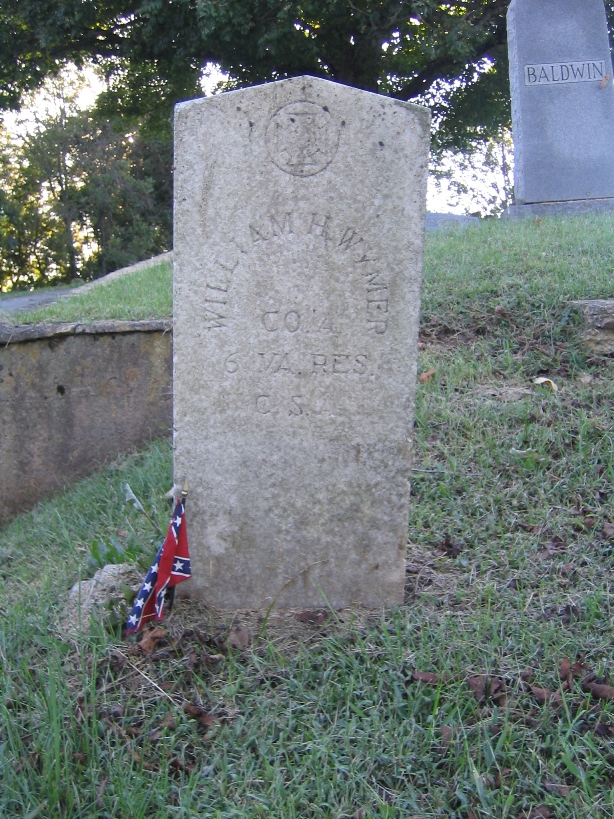
When I went home that afternoon, I began to search for more details. With some census research, I learned that he was the uncle of my great-grandmother, Mollie Weimer Overbay. Upon confirming his relationship to our family, I began searching for a pension application for his wife, Rhoda:
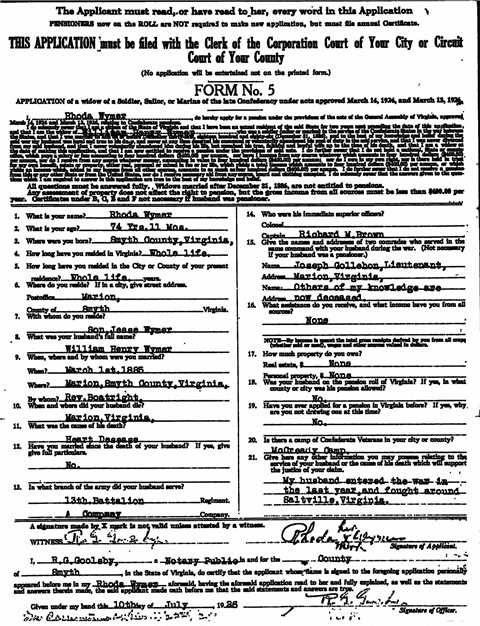
The application had been submitted in 1926 and told the story of William’s life. Among other things, I learned the answers to my questions about his service during the Civil War. His wife indicated that he enlisted during the last year of the war and was present during a well-known battle in our county—the Battle of Saltville. I am sure that my great-grandmother had grown up listening to tales of this battle and William’s experience during the war. The details of the story had been lost but were now re-discovered thanks to a trip to the cemetery.
Subtle clues like this one await you as you search out your own ancestors. The next time you make a trip to one of these libraries of marble, take a few moments to look closely at the clues that surround you. They may not be obvious, but they are there, waiting for your curiosity to uncover them. So, bring your cameras, your gloves, and your grass clippers to the cemetery on your next visit—but don’t forget to bring your questions and your ability to perceive the minute details, as you stand beneath the towering trees, among the rows of marble, waiting to offer up their long-held secrets.
More cemetery research tips
Disclosure: This article contains affiliate links and Genealogy Gems will be compensated if you make a purchase after clicking on these links (at no additional cost to you). Thank you for supporting Genealogy Gems.
by Lisa Cooke | Jun 8, 2016 | 01 What's New, Pinterest |
FamilySearch Family Tree plus Pinterest for family history adds up to cousin bait like you’ve never seen. Here’s a little-known technique to utilize both sites together for great results.
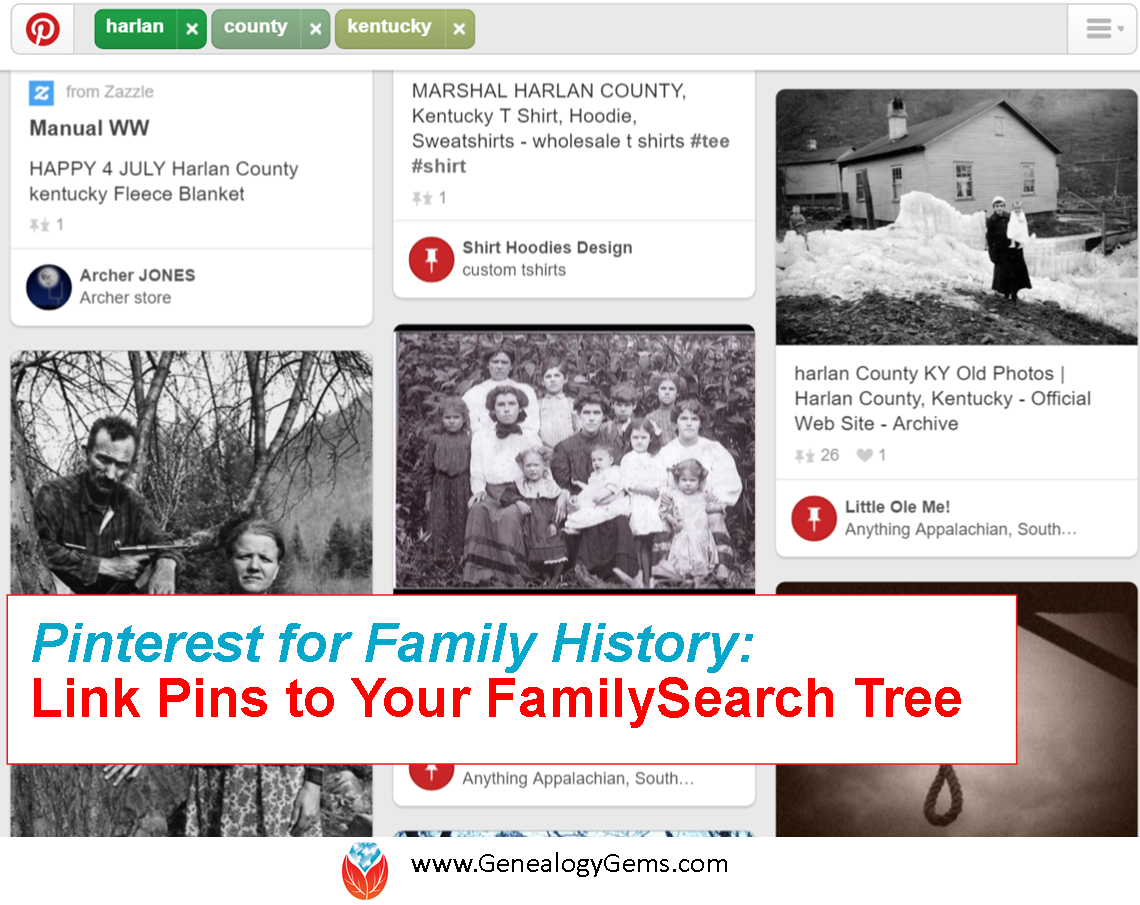
There is a little known secret: Pinterest and FamilySearch Family Tree can work together to reel in new cousin connections.
Pinterest is a free, online bulletin board where you can collect content that you find on the web. It’s a kick-back to the old days when we found pictures of our favorite home decor or recipes and tore out the pages of the magazine. Do you remember doing that? No longer do we need to tear out pages and file pictures and articles of our favorite things in old binders. You can use Pinterest to keep all of your items organized and accessible at the click of the mouse.
Pinterest is not a piece of software or something you download. All you need to do is go to www.pinterest.com and sign-up using your email or Facebook to create a free account.
FamilySearch Family Tree works similarly with their “Memories” section. The Memories section allows users to collect and store family photos, documents, stories, and even audio. But that is just the beginning! Pinterest provides you with a way to put these items to work for you. Photos, documents, and stories you post on a FamilySearch memories page can be pinned to your Pinterest board.
Why is this so groundbreaking, you ask? When potential cousins Google your common ancestor, the list of results will include your Pinterest board, like the search example below that finds my own Pinterest pins:

Then, when they click that great photo of grandma or the WWII story of great-grandpa on Pinterest, they are automatically directed back to your FamilySearch Family Tree where they can see your pedigree chart…for FREE!
(You don’t need an account to see, use, or search within the FamilySearch Family Tree. If you were to try this technique using images you have uploaded to a subscription site such as Ancestry, those clicking from Pinterest would simply land on the log-in page to Ancestry. Without a paid subscription, they go nowhere. How frustrating!)
How to Connect Your FamilySearch Family Tree with Pinterest Pins
1. If you haven’t already set up a Pinterest account, you will need to do that first.
2. Create a board specifically for the purpose of family history. I chose to create a board for each of the surnames that I’m actively researching. I would love to make some connections with other genealogists on these! “Bowser Family of Clark County, Ohio” and “Cole Family of Lee County, Virginia” are two examples. (Notice, I added a county name and state. I wanted to be sure I attracted people who searched by surname and/or place name.) Do not add any pictures to your boards yet.
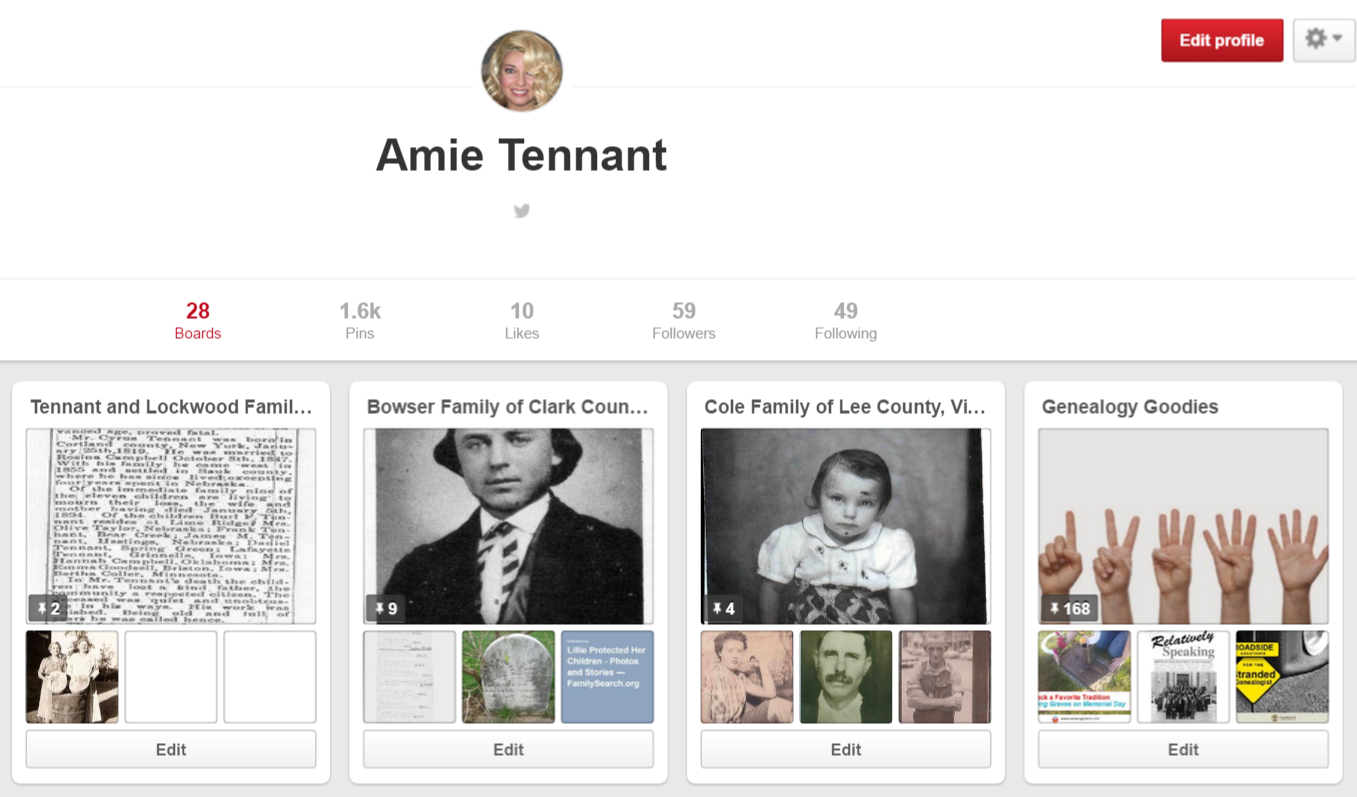
3. Create or log in to your free FamilySearch Family Tree with names and dates of your ancestors.
4. Click on an ancestor for whom you want to add a memory. At the “Person” page, click on “Memories” near the top. This will take you to the memory page where you will upload the photos, documents, and so forth for your specific ancestor.
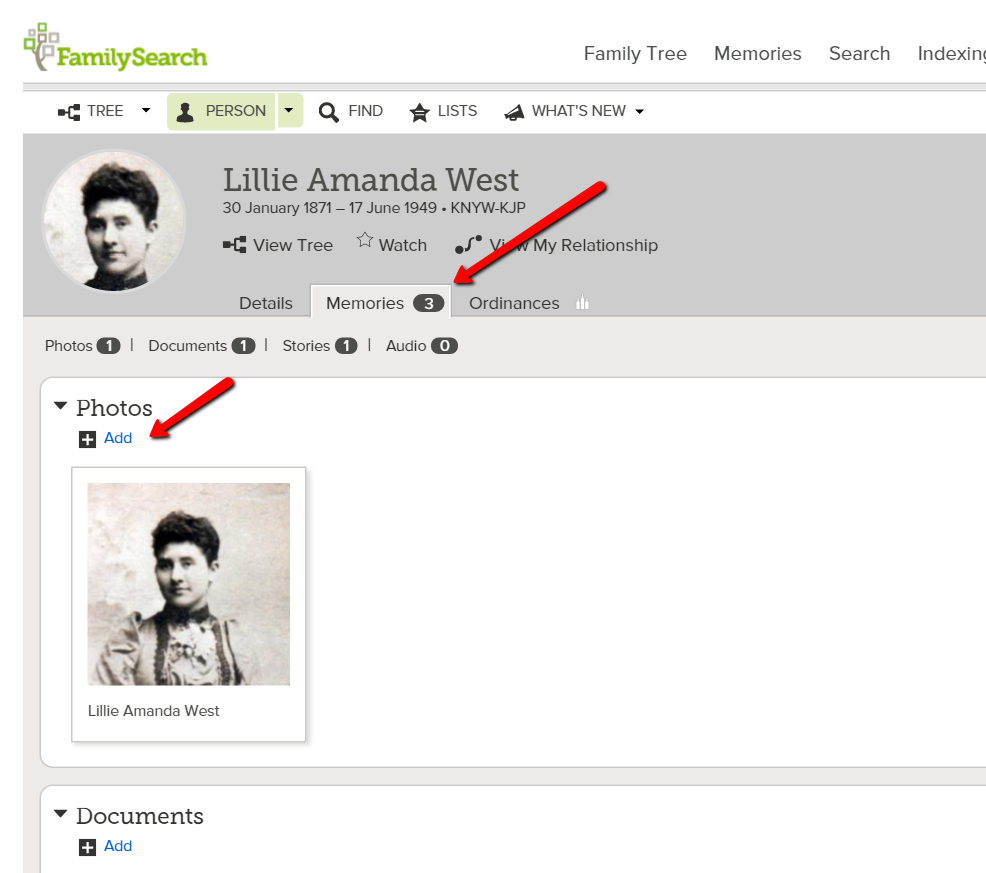
5. Add a title and an accurate, thorough caption. An example of a title might be a full name or a story title like: “When Her Baby Died.” A caption needs to include more details: “Lillie Amanda West, Clark County, Ohio. Wife of George Henry Bowser and daughter of Edmund West and Lavina Wilson. Picture taken ca. 1897.”
6. Once you have uploaded everything you wish with your titles and captions, go back to the FamilySearch Memories gallery page by simply clicking on “Memories” again. If you hover your cursor over a picture, document, or story you uploaded, a little “Pin It” box will pop up. (Important Note: FamilySearch reviews all items uploaded to the Memories section for inappropriate content. Because of this, you may have to wait a few minutes before your items are able to be pinned.) Now, click “Pin It” and follow the prompts to pin the item to the Pinterest board of your choice. You will need to copy and paste or create a new caption for your pin. Click the little pen below the picture to edit the caption. (Remember, this caption will be what you want to be Google-searchable, so pack it with names and words that you think your long-lost cousins might type into the Google search box when searching for those ancestors. (Need help with Google search terms? Lisa Louise Cooke’s book The Genealogist’s Google Toolbox, 2nd Edition is your go-to resource.)
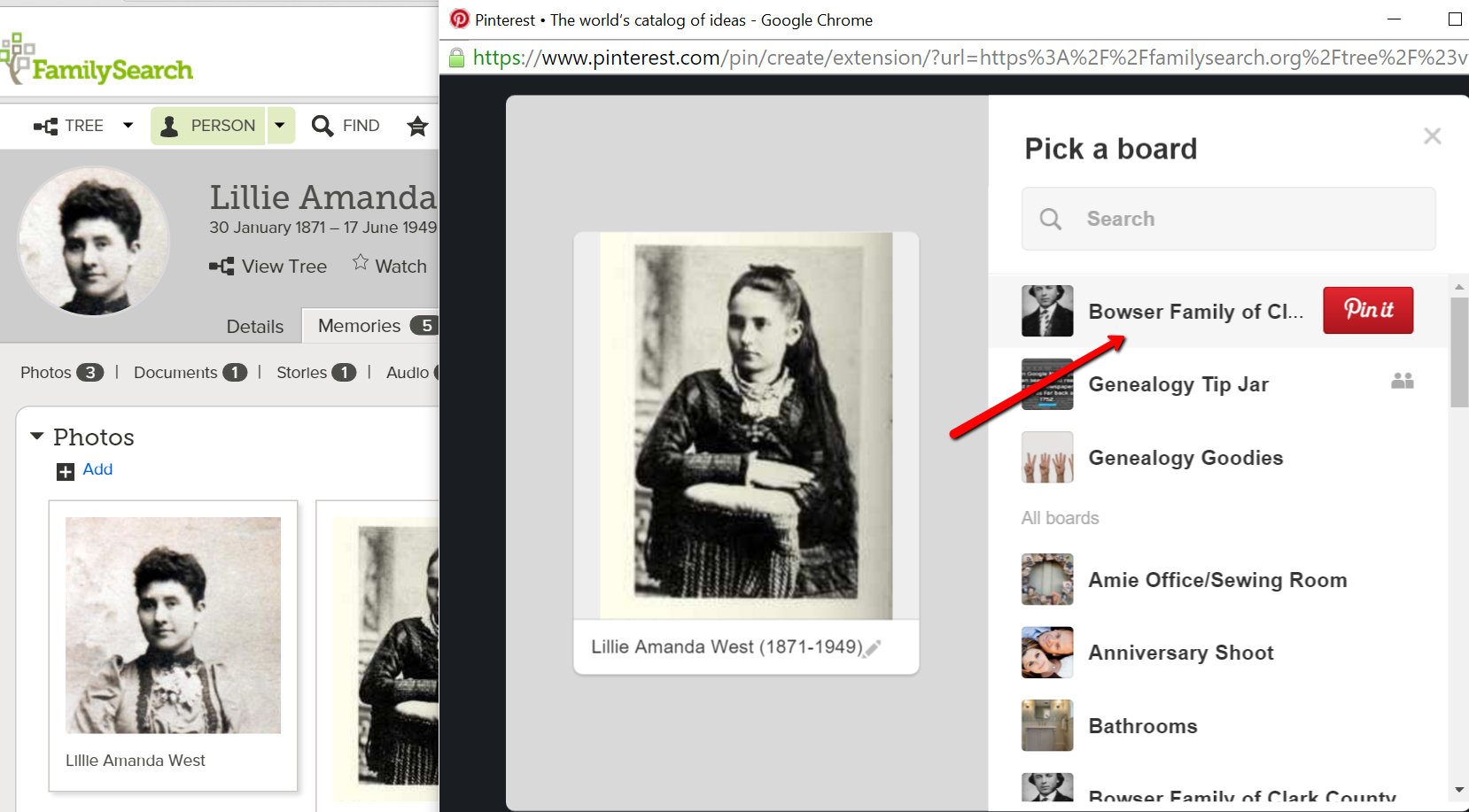
Cousin connections often bring to light new and exciting pieces of your family’s story. Try using Pinterest and FamilySearch Family Tree today as cousin bait to find long-lost family members anywhere in the world.
More Gems for Pinterest for Family History
by Lisa Cooke | Jul 26, 2017 | 01 What's New, Archives, Records & databases
Original manuscript records may reveal genealogical gems about your ancestors. Find these old records in archives around the country using this little-known, free online tool: ArchiveGrid.
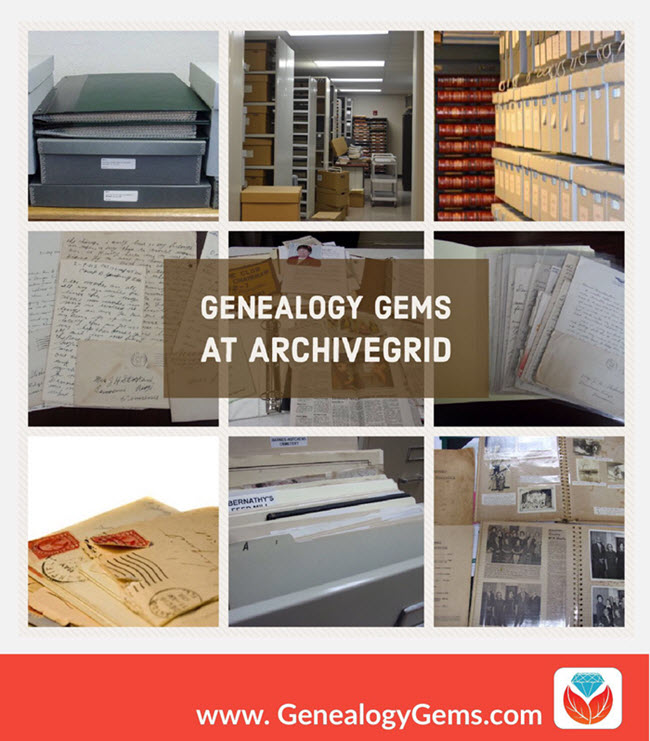
Manuscript records such as old diaries, letters, vital record collections, military documents, church registers, store ledgers, school and even business records can be genealogical gems. But finding original manuscript collections in archives and libraries can be difficult. Which archive has it? What’s the collection called? How can you access it?
ArchiveGrid can help
A little-known free website can help you locate old documents and manuscript items available in over 1,500 different archival collections. It’s called ArchiveGrid, and it currently includes close to 5 million archival item entries!
ArchiveGrid is a companion website to WorldCat, the free online catalog of millions of library items from thousands of libraries. The difference is that ArchiveGrid focuses not on published items but (generally-speaking) on unpublished ones.
How to search ArchiveGrid
From the ArchiveGrid home page, you can do two types of searches:
Search for repositories in ArchiveGrid
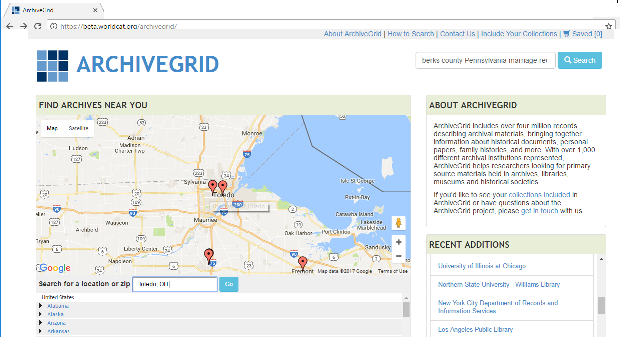
Use the map view, shown above on the left side, to identify archival collections that are near your ancestors’ home. These archives may hold materials related to your ancestors’ communities. Hover over the red markers to see the names of institutions. Click on them to find contact information and search their collections.
Search for specific manuscript items in ArchiveGrid
1. In the search box in the upper right part of the ArchiveGrid home page, enter search terms related to the manuscript items you hope to find, such as berks county pennsylvania marriage records. Then click Search. You’ll see a list of search results, such as these:
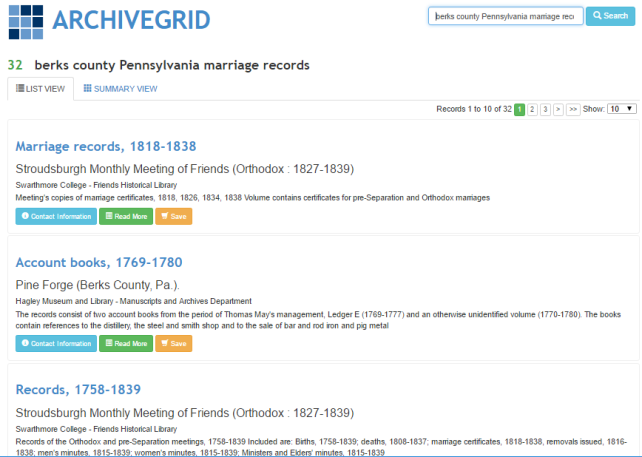
2. Browse search results. If you need to narrow or broaden your results, you can scroll to the bottom of the search results page and click the options you want.
3. Click on items of interest to read more about them. Here’s what a typical ArchiveGrid catalog entry looks like:
 The entry tells you more about the individual item. You may see when it was created, a physical description of it, who or what organization created it, and even brief historical background. You’ll see what repository holds it–and you can click under the name of that repository for its contact information. You may be able to order copies, visit to view the item in person, or hire a local researcher to do that for you.
The entry tells you more about the individual item. You may see when it was created, a physical description of it, who or what organization created it, and even brief historical background. You’ll see what repository holds it–and you can click under the name of that repository for its contact information. You may be able to order copies, visit to view the item in person, or hire a local researcher to do that for you.
As you can see, a sidebar to the right of this catalog entry says More Like This, with categories like people, places, groups, or topics. These links point to additional catalog items that are related in some way to the one you’re looking at—it’s something like browsing the stacks by topic at a library. (You can also sort all your search results this way from the main list of search results by clicking on Summary View.)
Now that the Family History Library is discontinuing its microfilm lending program, you may find yourself increasingly searching for original manuscript items that aren’t available online. And now that you know how to use ArchiveGrid, you may find yourself wanting to seek out these genealogical gems even more!
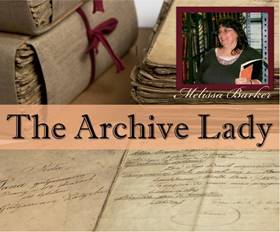 Learn More About Original Records
Learn More About Original Records
Learn more about finding and using original records from our new regular contributor on the Genealogy Gems podcasts: “The Archive Lady” Melissa Barker. Hear a full-length interview with her in the free Genealogy Gems Podcast episode #205. Genealogy Gems Premium website members can hear even more from her on finding and using original records in the Genealogy Gems Premium Podcast episode #149.
Photos used in the collage in this post are courtesy of Melissa Barker.
by Lisa Cooke | Jun 6, 2016 | 01 What's New, Apps, Book Club, Mobile, Smartphones |
Wish someone could read your Kindle e-book to you? Your iPhone can. Here’s how to turn a Kindle ebook into an audiobook. For free.

Turn eBook into AudioBook
I love to read. But when I’m on the road, doing chores or working out, it’s easier to listen to books. Sometimes I purchase an audio format or find one at my local library. But audiobooks are pretty expensive, and they’re not always available for the books I want.
So what if I have an e-book already on my Kindle and I want my iPhone to read it to me? It can.
Here’s how to turn a Kindle ebook into an audiobook on an iPhone 5s:
1. Customize VoiceOver settings. On your iPhone, go to Settings > General > Accessibility.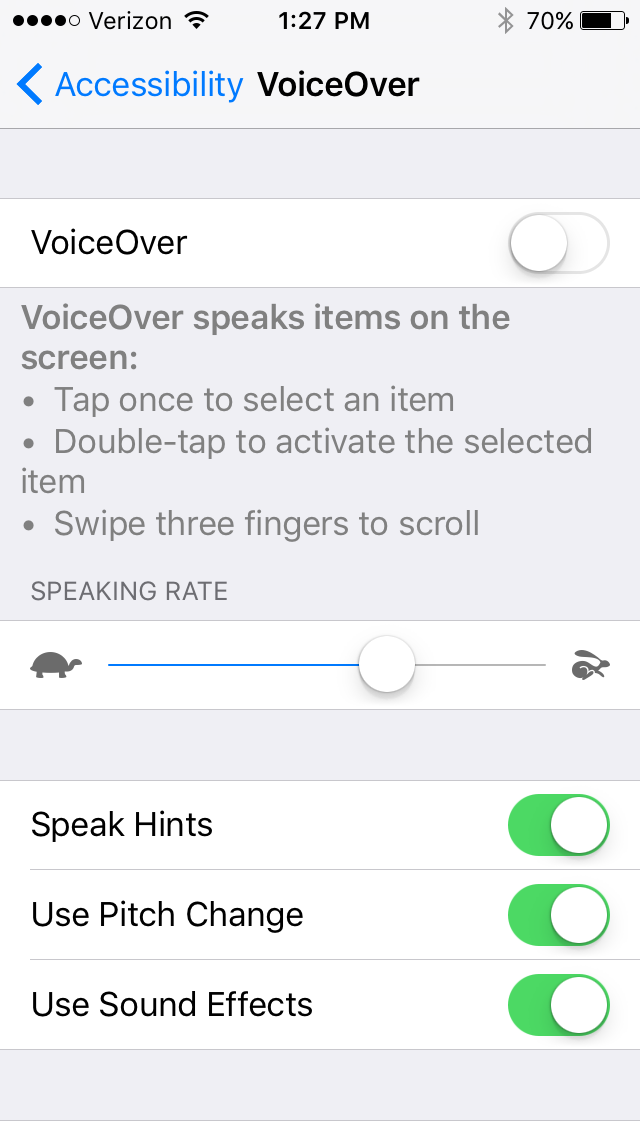
2. Set the reading speed. On the VoiceOver screen, go down to the Speaking Rate bar and adjust it to a speed you like: toward the turtle image for slower, and toward the running rabbit for faster.
3. Choose the reading voice. On the same screen, you can select the voice you want to hear. Choose Speech. Under Default Dialect, you can choose among several English-speaking reading voices, categorized under U.S., Australian, U.K., Irish and South African English. Or tap “Add New Language” to enable one of many other languages.
4. Open your Kindle app (or download it here).
5. Choose a book from your Library. Or go to Amazon.com, select Kindle Store under the All Departments dropdown menu on the search bar, and search for titles (or search “Kindle free books” for free Kindle books to read). You should also check with your local library about borrowing Kindle ebooks.)
6. Open the book. Tap the book and swipe left to page forward through the front matter until you want to start reading.
7. Ask Siri to “turn on VoiceOver.” You can also do this manually by going back to Settings > General > Accessibility. Once you turn on VoiceOver, it reads everything to you. I find it annoying and more difficult to navigate in the iPhone with VoiceOver on, so I don’t enable it until I am ready to use it. After Siri confirms that VoiceOver is enabled, press the Home button once to return to your Kindle book.
8. Start the audio reading. A black border will appear around your Kindle book page. A voice will start to give you instructions. Swipe down with two fingers to begin reading continuously (beginning with the current page and continuing through the book until you stop.
9. Double tap the screen to stop reading and bring up the menu options.
If you’re used to audiobooks read by actors and professional readers, you’ll miss their polished performances. But the voice works for me in a pinch, when I just want to listen to an e-book I already have on my Kindle.
Why not try this with the current Genealogy Gems Book Club featured title, The Summer Before the War by Helen Simonson? Click on the book title to order the Kindle e-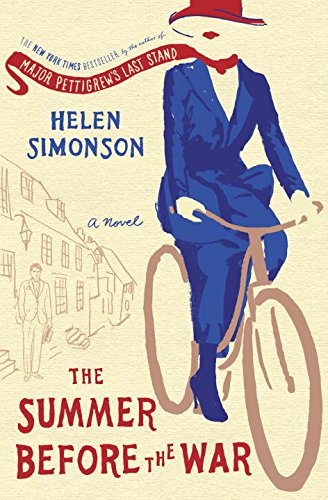 book. It’s a perfect summer read: a light-hearted romance with colorful characters and a compelling historical backdrop at the outset of World War I.
book. It’s a perfect summer read: a light-hearted romance with colorful characters and a compelling historical backdrop at the outset of World War I.
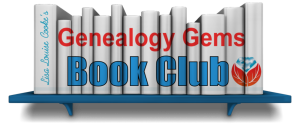 This post was brought to you by the free, no-commitment online Genealogy Gems Book Club. We choose titles for their appeal to family history lovers, AND we interview their (often best-selling) authors. Click here to learn more about the Genealogy Gems Book Club.
This post was brought to you by the free, no-commitment online Genealogy Gems Book Club. We choose titles for their appeal to family history lovers, AND we interview their (often best-selling) authors. Click here to learn more about the Genealogy Gems Book Club.
by Lisa Cooke | Aug 17, 2016 | 01 What's New, Video
Here’s an inspiring example of a quick and easy way to tell your story. Every one of us is deeply connected to history through our family stories. In fact, exploring your family history story can help you learn more about your place in history and what makes you, you.
Tell Your Family History Story with Animoto
Were you one of those kids sitting in history class bored to tears? Was the common teenage mantra “what’s this got to do with me?” running through your brain? While the teacher’s lecture may have seemed disconnected, nothing could have been further from the truth. Every one of us is deeply connected to history through our family stories. In fact, exploring your family history story can help you learn more about your place in history and what makes you, you.
(Full disclosure: This post contains affiliate links and I will be compensated if you make a purchase after clicking on my links. Thank you for supporting the Genealogy Gems blog!)
We all have a story to tell about our place in history and Animoto is an easy and powerful way to tell that family history story. I’ve been sharing my thoughts on creating family history stories on my Genealogy Gems Podcast and in videos on my Genealogy Gems YouTube channel. One of my listeners and viewers, Doug Shirton, has enthusiastically embraced the idea of video storytelling and recently shared his video with me.
is an easy and powerful way to tell that family history story. I’ve been sharing my thoughts on creating family history stories on my Genealogy Gems Podcast and in videos on my Genealogy Gems YouTube channel. One of my listeners and viewers, Doug Shirton, has enthusiastically embraced the idea of video storytelling and recently shared his video with me.
Doug says “I have been wanting to do a video for a long time…Animoto was so easy.” Take a few minutes and get inspired by watching Doug’s video Genealogy Journey; Doug Shirton by clicking here.
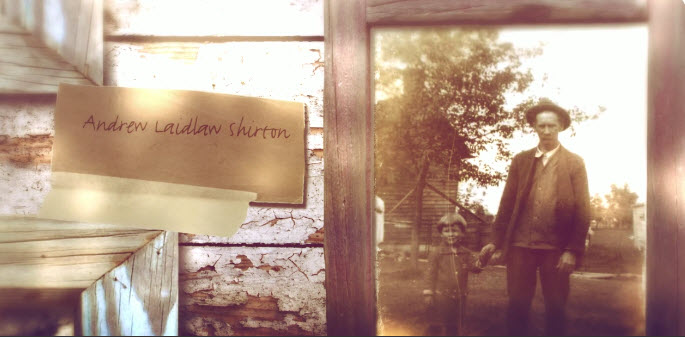
I love the elements that Doug wove into his video. Not only did he include individual photographs of himself and his ancestors, but he also dragged and dropped into his Animoto timeline a full page family tree chart. Doug used the “Rustic” video style (one of my favorites) which is perfectly suited for his old-timey photos.
He also used music in an innovative way to tell his family history story. Rather than settling on just one song, he used portions of multiple tracks. This technique moves the viewer through the emotional levels he was striving to convey.
Adding Music to Your Family History Story
All great movies have a soundtrack! Animoto allows you to choose from their music library or add your own. Adding music to your family history video is very simple. To add additional songs, simply click the plus sign under the timeline. Animoto’s “edit song and pacing” feature makes it easy to get everything to fit perfectly.

MUSIC SEARCH TIP: In addition to being able to upload your own songs, Animoto’s robust music library is brimming with songs that will help you hit just the right note. In addition to the filter boxes, don’t miss the handy search field at the very bottom of the list of filters. Enter a keyword to suit your mood and then scroll back up to the top of the page to pick from the results.
Choosing the Focus of Your Family History Story
Family trees are very far-reaching indeed. So many direct line and collateral lines, often spanning the globe. Doug was wise to select one family history story within his tree: his Ontario, Canada pioneer ancestors.
Focusing on a particular line of your family, or a single story makes creating your video more manageable for you and, frankly, more enjoyable to watch for your viewer. Keeping your video fairly short is also a good idea. Doug’s is just 4 minutes and I recommend going no longer than five. This is particularly important when you plan to share it on social media where attention-spans are short.
Family History Story Ideas
Here are a few ideas of stories you could explore:
- The story of your most recent immigrant ancestor
- A family history story that runs through your family tree, such as three generations of musicians
- How one of your ancestral families survived a natural disaster like the Johnston Flood or the Great San Francisco Earthquake
- The history of a first name that was used over multiple generations in your family
The idea here is to select a family history story that is short, thematic, and compelling to watch.
Need More Ideas?
Visit my How to Create Family History Videos page for more ideas and step-by-step instructions for videos with Animoto, There’s no better time than now to tell your story! We would love for you to share your family history story video on our Facebook page.
Here’s the book that will help you cultivate and record your story: Story of My Life: A Workbook for Preserving Your Legacy.
Disclosure: This article contains affiliate links and Genealogy Gems will be compensated if you make a purchase after clicking on these links (at no additional cost to you). Thank you for supporting Genealogy Gems!





 Billion Graves allows users to collect photos of headstones by using an iPhone/Android camera app.
Billion Graves allows users to collect photos of headstones by using an iPhone/Android camera app.




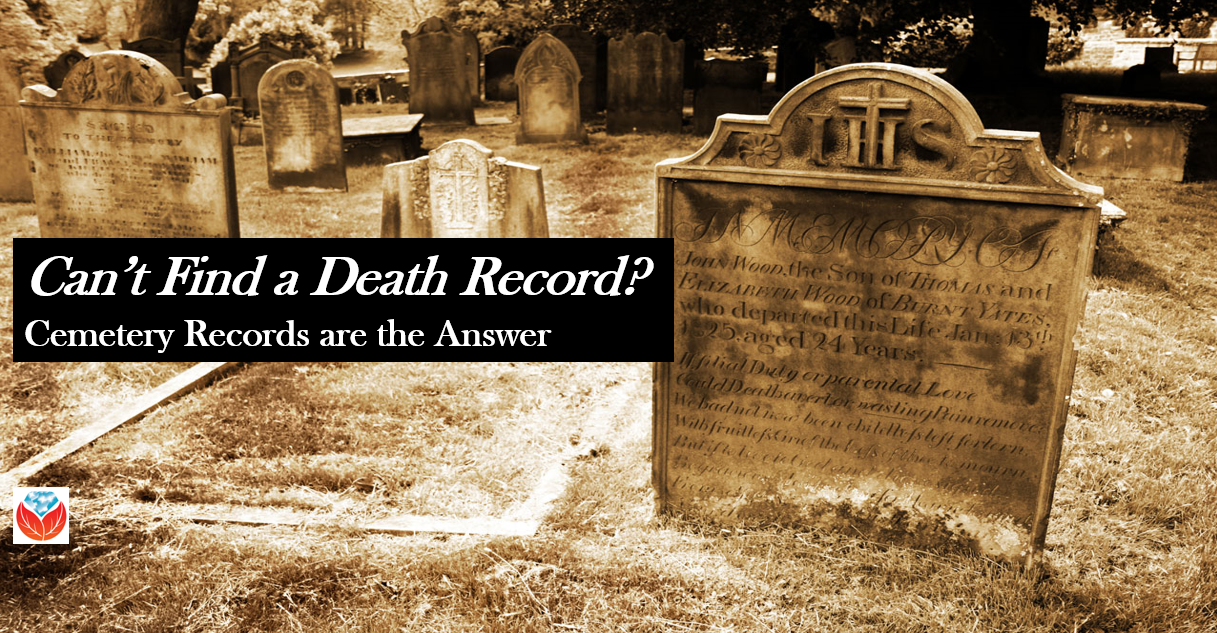










 The entry tells you more about the individual item. You may see when it was created, a physical description of it, who or what organization created it, and even brief historical background. You’ll see what repository holds it–and you can click under the name of that repository for its contact information. You may be able to order copies, visit to view the item in person, or hire a local researcher to do that for you.
The entry tells you more about the individual item. You may see when it was created, a physical description of it, who or what organization created it, and even brief historical background. You’ll see what repository holds it–and you can click under the name of that repository for its contact information. You may be able to order copies, visit to view the item in person, or hire a local researcher to do that for you. Learn More About Original Records
Learn More About Original Records

 book. It’s a perfect summer read: a light-hearted romance with colorful characters and a compelling historical backdrop at the outset of World War I.
book. It’s a perfect summer read: a light-hearted romance with colorful characters and a compelling historical backdrop at the outset of World War I. This post was brought to you by the free, no-commitment online
This post was brought to you by the free, no-commitment online 
